|
Website visitor Barb H. wrote to
ask that I provide her with a copy of the page in the January 1972 issue of
American Aircraft Modeler that her brother, David Downey, had a suggestion
of his printed. It appeared in the "Where the Action Is: Control Line" column.
John Blum wrote the "Carrier and Stunt" section
and mentions David's idea of using a section of
neoprene tubing around the
outside of the elevator pushrod in order to minimize flexing under load. The tubing
is to be glued to the fuselage structure in three inch or less interval along its
length. Interestingly, Mr. Downey submitted his entry from
Manaus, Amazonas, Brazil, which
today is the seventh largest city in Brazil. The column also has a report which
is funny in retrospect, but was potentially very dangerous at the time. It is in
the Speed and Racing section and involves a situation
that resulted in the unplanned disrobing of a pilot as his model rocketed around
the circle at 200 mph. If a camera-equipped cellphone had been on-hand then
as would have been the case today, the video would certainly have been a YouTube
sensation! It would also probably have appeared in Dave Gee's "Safety Comes First"
column in the AMA's current publication Model Aviation.
Where the Action Is: Control Line
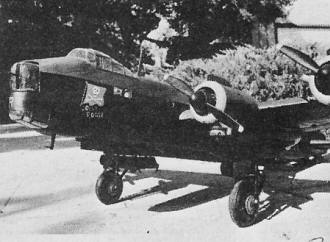
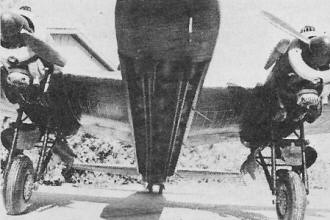
Super detail on Ed Dunstan's Short Sterling WW II bomber includes
operating bomb bay doors, bomb release, revolving turrets, moveable guns and flight-operated
flaps and throttle on the four growling 19's. Weighs only 13 lbs.
Bill Boss
Sport and Scale
Tips For Successful Rat Racing: Howard Shahan, an experienced Rat Race flier
of San Diego, Calif., has some advice for beginners in the event. While his remarks
are aimed specifically at Rat Racing, they can also be applied to other types of
CL flying.
A most important first step is to structure the plane and its control system
so it is strong enough to withstand the rigors of the event and repeated pull-testing.
Good flying wires and strong line connectors are a must. Howard makes up line connectors
that will withstand 100·lb. pulls by taking the sliding lock from '''Perfect'' line
connectors and replacing the connector with those formed of .045 music wire.
Balance of the plane is next. Add wing tip weight of 1/2 oz. on Scale racers
(Goodyear) and a 1-oz. weight on rats of average spans. Trim the plane for a slight
nose-heavy condition without making the plane sluggish. The balance point should
be in the area from the leading edge of the wing to about 3/8" back from the leading
edge. A little experimentation will find the best point. Another item to be considered
when balancing the plane is the placement of the landing gear on a single-wheel
equipped plane. Be sure to mount the gear just inside the centerline on the inboard
side of the ship. Putting the gear too far outboard can neutralize the effect of
the wing tip weight.
Sensitivity of the control system should be kept to a minimum. With the high
speeds of these planes large tail surfaces are not required. When installing the
control system a 2" bellcrank should suffice. Install pushrod and leadouts in the
holes closest to the bell-crank center pivot point. Push rod should be entered in
a hole of the elevator control horn about 3/8" to 1/2" from the surface of the elevator.
Elevators of 10 to 20 sq. in. should be adequate.
The last item for consideration is the angle of attack for takeoff. Keep the
angle at approximately 15 degrees for straight smooth takeoffs. Add a tail skid
if necessary to achieve the proper angle. Low, smooth take-offs will keep you from
making jack-rabbit starts that put you right in the path of planes already flying
in the circle. Following these basic technical tips should get the beginner off
to a good start. Even the more experienced fliers might find them helpful.

Lexington, Kentucky, Nats entries are Kenny Stevens, age 11,
Lew McFarland, Bill Richardson and Ralph Wenzel.

Pushrod idea by David Downey.
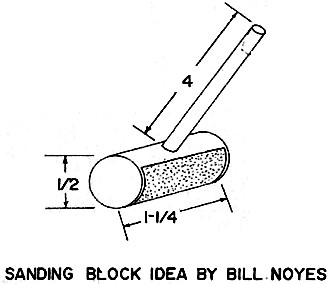
Sanding block idea by Bill Noyes.

Mauler and Panther for Carrier and Stunt in Navy colors and K&B
35's, both throttled are by Joe Averitt.
Scale Tech Tip: A quick and easy way for a beginning scale modeler to make turnbuckles
for early aircraft is to use 1/16" OD brass tubing and soft florists wire. The procedure
is simple. Cut brass tubing to desired length, make small loop on one end of a piece
of the wire, insert wire through tubing, make small loop on other end and cut off
excess wire, paint desired color and PRESTO - a simulated turnbuckle. Tom Fluker,
originator of this item, also points out that elastic thread can be used for the
wire rigging. The thread gives a taut-looking rigging and is easily made.
John Blum
Carrier and Stunt
What's In A Handle: UC mayor may not be demanding on the type of control handle
used. Basically, it's whatever the pilot is comfortable with. In stunt, every shape
and size known to man has been used. The same holds true in Sport flying. The serious
stunt fliers usually prefer a smaller sized handle, such as the small E-Z-JUST,
or one that permits adjustment between the line connectors at the handle. These
features reduce the possibility of over-control of the aircraft. The larger control
handles, such as the larger E-Z-JUST, induce an extreme amount of control with the
lines far apart, which is not desirable for stunt.
Another factor is the novice that over-controls on "down" maneuvers, but not
on "up." This situation may be induced by the setting of the control handle for
neutral elevator position. If the handle position for neutral is perpendicular to
the ground, the wrist movement will permit more "down" than "up." With the handle
held vertically, adjust the lines to permit the top of the handle to tilt forward
about five degrees for neutral elevator. When one's arm is fully extended, with
hand firmly clasped about the control handle, the wrist should assume an in-line
relationship with the arm. In this position, one will note that the center of the
grip is not perpendicular to the ground and represents the proper position for neutral
elevator. Aircraft control is more comfortable when this phenomena is realized and
permits more equal "up" and "down" handle travel. For example, a pistol grip is
tilted forward because that is the comfortable, proper way to hold and fire it.
The control handle should assume this natural position.
Pushrod Stiffness: Sketch depicts a method used by David Downey (Manaus, Amazonas,
Brazil). Neoprene tubing is placed over the pushrod. This push rod is a size which
permits it to move freely through the tubing. The tubing must be secured at every
three inches of its length, with the secured ends within one inch of the horns.
David relates that the system can be used with or without the wing flaps.
Sanding Fillets: Bill Noyes (Valinda, Calif.) presents the idea in the sketch
of a fillet sanding block. Sizes can vary from that shown in the sketch, depending
on the job to be done. Use different size dowels for different size fillets. Glue
the desired grit sandpaper over two-thirds of the dowel and go to work.
John Smith
Speed and Racing
FAI Finals: Labor Day weekend found the top FAI fliers in Cleveland battling
for a place on the U.S. FAI team. For Speed the top three are: Carl Dodge with a
15.43 average time (two best flights); Bob Spahr, 15.595; Chuck Schuette at 15.825.
Carl used a Dodge-TWA engine while Bob and Chuck both ran Rossi power. In T.R. the
top dogs are: Roger Theobald-John Barr, running a 4:34.7; Jim Dunkin-Bill Wright
at 4:44.85 and J.E. Albritton-John Marvin with a 4:44.9. Competition was great and
the teams picked, with a little bit of luck, should be able to take all the marbles
next summer. We still have to get them over there so send your money for your AMA
FAI shirt patch and decals. Specify which you want. They are representing you, so
don't let them down.
Almost A Nasty Accident: While trying for the C record the Frye-Roselle team,
which came out of "retirement" for the Dayton, Ohio Buzzin' Buzzards Meet, Sept.
11-12, washed out their record-holding C model. As Jerry went for the pylon, he
was pulled through it and while trying to get in again his trousers hooked on the
pylon adjusting bolt. Meanwhile the model, turning at 200-plus mph, got ahead of
him. When Jerry tried to catch up, he ended up flying almost in the all-together.
His pants were completely ripped off but luckily he didn't get hurt. The model went
in and was destroyed. The extent of engine damage is unknown and Jerry, due to the
quick-thinking gang in the pits, can still face his friends. He sure looked cute
in those blue denim "hot pants" someone brought him.
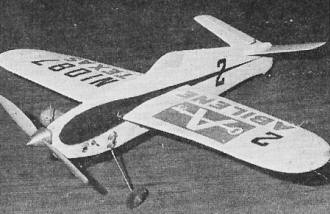
Jerry Farr's nice ST pulled Swee Pea racer.
Paint Drying Tip: When you are ready to paint a model, park your car in the sun.
Put the finished painted model in the trunk and lower the lid. In a couple of hours
you'll have the nicest dust-free, baked-on finish you could ask for. Try it. It
works.
Howard Rush
Combat
FAI Combat: Combat may become an official event in the CL World Championships.
The subject will be raised at the CIAM meeting in Europe this winter. Although FAI
rules are frozen for five years, it may be possible to add the Combat event, for
which rules already exist. Laird Jackson, USA CL Program Administrator, reports
that chances for Combat as an official event in the 1974 World Championships are
doubtful, but he will investigate the possibility.
Copies of the FAI Combat rules can be found at AMA headquarters. Briefly, rules
are as follows: Maximum engine displacement is 2.5 cc (.15 cu. in.); lines are 0.012"
diameter, 52'3" long (monoline not permitted). Two planes and two sets of lines
may be used per match. Streamers are 1.2" wide crepe paper ten feet long with a
6'7" string leader.
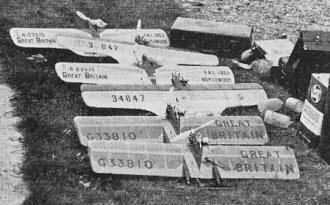
Combat design has not changed too much in FAI meets since '63.
They are not identical in features to our AMA 35-powered planes.
Prior to the match is a 30-second engine warming period, then 30 more seconds
until the engine starting signal. The scoring period begins with the engine starting
signal and lasts four minutes. During this period, each contestant gets one point
for each second his plane is in the air and 100 points per cut. There are no kills
as in AMA Combat and no points are given for cutting the string leader. Combat begins
at a signal from the judge when both planes have completed two level laps and are
separated by at least a quarter lap. A pilot can be disqualified for intentionally
leaving the ten-foot radius center circle and is penalized 50 points when he accidentally
steps outside the center circle. Although not clearly stated, it appears that-a
mid-air collision does not end the match. No fuel restrictions are mentioned.
Combat Abroad: 15-size Combat has been flown in England for several years and
it is becoming increasingly popular in Europe. Down Under in Australia they fly
both 15 and 35 classes, although the smaller class is becoming the standard contest
event. Combat has been a side event at past FAI World Championships and the Russians
have been winning. Keep us informed of FAI Combat activity by writing Howard Rush
in care of AAM.
On Safety: AMA rules provide for circle markings and procedures to avoid planes
hitting pit crews. Follow these rules in both Fast and Slow Combat. Slow Combat
planes are generally heavy, so they can hit hard. Circles can be easily marked with
hydrated lime available from garden shops.
Posted January 8, 2020
|